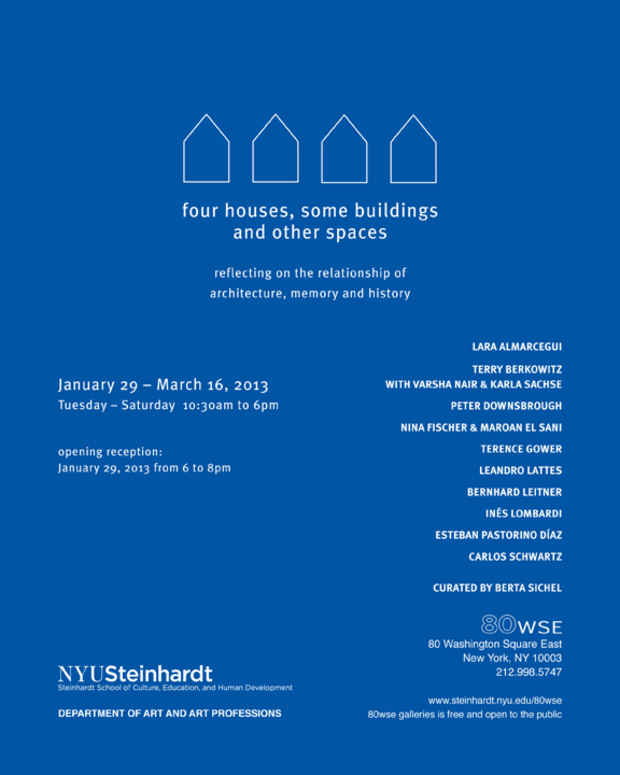"4 Houses, Some Buildings and Other Spaces" Exhibition
80 Washington Square East

This event has ended.
80WSE presents “Four Houses, Some Buildings and Other Spaces,” curated by Berta Sichel. “Four Houses,” is an exploration of the bond between architecture and history, delving into the complex relationship between ruins and memories and bringing deeper insight into the nature of the history of places and their social and cultural implications.
The 10 artists in the exhibition, Europeans, Americans and Latin Americans and from different generations, revisit the history of monuments, houses, municipal buildings -- places that were once hallmarks or centers of production and that have become more or less an unseen area in the contemporary landscape. For these artists revisiting these ruined and forgotten building that once held a special significance opens up creative areas of memory, the imagination and interpretation.
Bernhard Leitner's project, The Saving of the Wittgenstein House Vienna (1969-71),is about the house the philosopher Ludwig Wittgenstein designed and built in l926 in Vienna for his sister. Now an embassy of an Eastern European country, it has lost its prior aura and sense of place in history as documented in this show.
New York resident Terence Gower makes a fictional prospectus for the utopian town of Hirshhorn, Ontario, planned in 1955 in the wilderness of Canada, but never built. The town was the brainchild of Joseph Hirshhorn, the uranium tycoon and designed by the celebrated American architect Philip Johnson to house uranium miners and Hirshorn’s famous collection of modern art.
Brazilian/Viennese artist Inés Lombardi’s “Past Present – Close and Distant,” abstractly reconstructs the architecture of one of the landmarks of Brazilian architecture: the house designed for entrepreneur Olivio Gomes in 1949 in Säo Paulo by the rationalist architect Rino Levi.
The young Argentinean artist now based in Madrid, Esteban Pastorino Dîaz’s research presents his travels around the rural communities of Buenos Aires. His goal was to create a photographic survey of the work of architect Francisco Salamone who built more than 60 municipal buildings with Art Deco/Futurist elements. Pastorino’s work explores the symbolic and ideological implications of this building program.
The Berlin-based duo Nina Fischer / Maroan el Sani presents a two-channel video projection with photography, addressing the theme of ruins. Their work, “Spelling Dystopia” offers images of an urban planning disaster on an island off the Japanese coast. “Spelling Dystopia” asks how memory operates and how a site wears its history, both physically and metaphorically.
Spanish-born Lara Almarcegui documents processes of urban transformation brought on by political, social, and economic change. Her installation “Guide to Al Khan, an empty village in the City of Sharjah” examines a former fishing village first established around 1820 in the United Arab Emirates, f depopulated around 1980 and now resided in by migrant immigrants who dwell in dilapidated housing.
Leandro Lattes’ “While Stocks Last: Urban Details from Madrid” previously published as a book, portrays bars and small stores from the Franco years that have a distinctly Madrileno style and are fast-disappearing as the city modernizes.
The work of the American-born, European residing conceptual artist Peter Downsbrough, registers the passage of time and the devastation it provokes in architectural structures and constructions. His photographs and videos document deterioration and falloff.
The passage of time is approached differently by another American artist, Terry Berkowitz. Her work “Barriers and Beyond” interleaves images of the Berlin Wall and bunkers built in Denmark during World War II. They document the “concrete blocks” that are “the first throw-offs of the history of frontiers,” in military actions all the more poignant now that their function has lapsed.
Spanish artist Carlos Schwartz’s drawings from the series “Blind Windows”(2010-2012) are inspired by the work “Moskau – Moscow” by Günther Förg. Förg’s work consisted of over one hundred photographs of Russian avant-garde buildings from the early 20th century. “Blind Windows” focuses on exact details of those buildings’ facades.
The exhibitions organizer, Berta Sichel is an independent curator working internationally. From 2000 to 2011 she was the director of the Department of Film and Video at the Reina Sofía Museum in Madrid. In 2006, she selected the Reina Sofia’s historical video collection and presented the exhibition First Generation: Art and Moving Image which was selected by the Spanish art critics among the three best exhibitions of the year in Spain.
Born in Brazil, Sichel moved to New York in 1979 and graduated from New York University with a Masters Degree in Media Ecology and pursued doctoral studies at NYU in Communications. During her time in New York, Sichel worked as an independent curator for North American and European Institutions, including the São Paulo International Biennial and Aperto-93 at the Venice Biennial. Among other prizes and awards, she was a recipient of the l998 Guggenheim Fellowship in Humanities/Fine Art Research.
Media
Schedule
from January 29, 2013 to March 16, 2013
Opening Reception on 2013-01-29 from 18:00 to 20:00